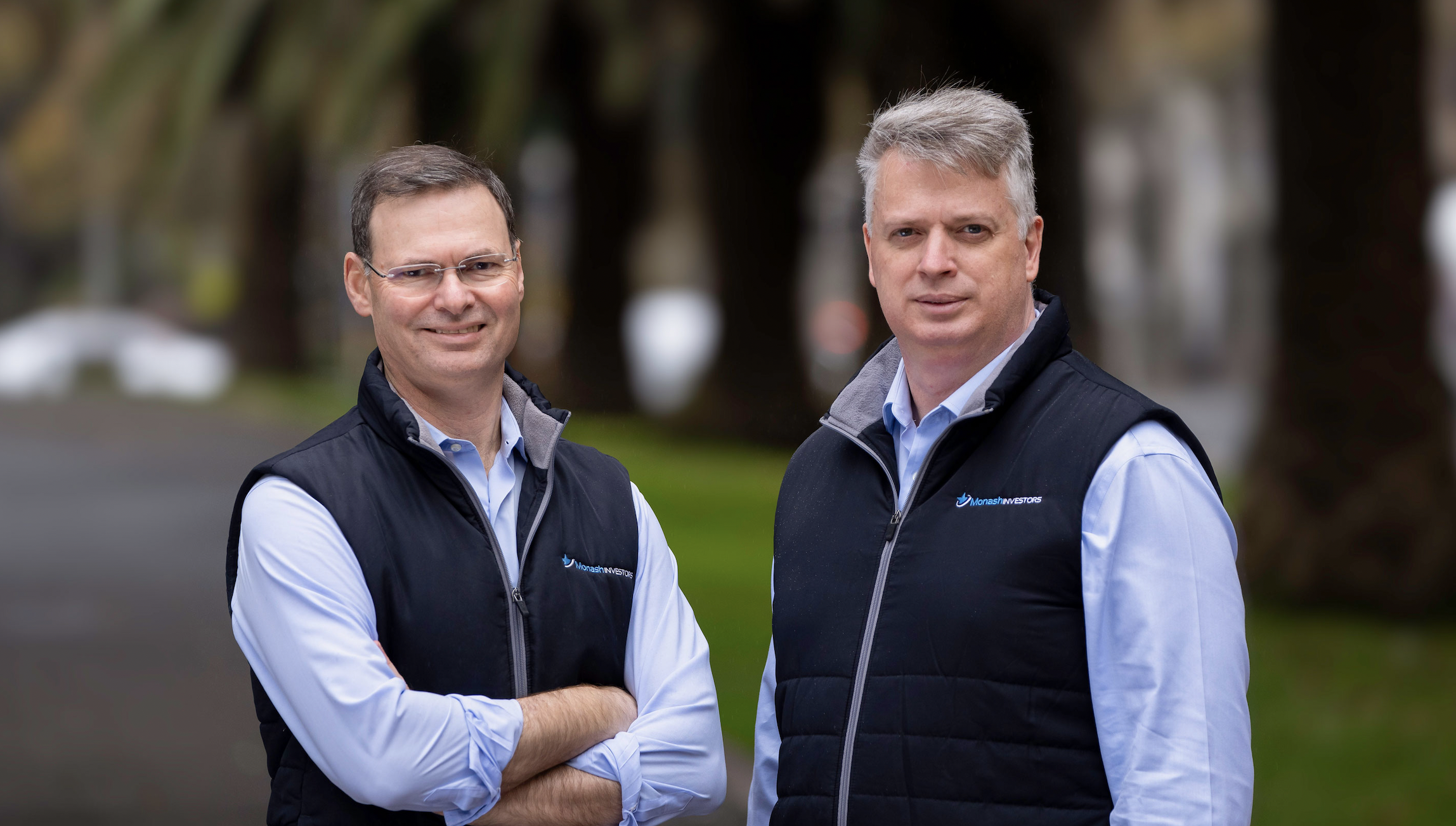The men who ditched the LICs and built a two-strike sell test

Livewire Markets
Monash Investors hit headlines recently when it dropped the fund's Listed Investment Company (LIC) structure for a more favourable Exchange-Traded Managed Fund (ETMF) structure - one of the first fund managers in Australia to make such a unique transition.
In a nutshell, Monash Investors Limited believes the change will ultimately benefit investors, and give them more liquidity and access to the fund.
“The only decision (investors have) got to make now is whether they like us as a manager or not," said Monash co-founder Shane Fitzgerald in a detailed webinar on the change, covered by Livewire Markets.
If this is the case, well then, who are the maestros behind this change in key?
I recently sat down with co-founders of Monash Investors, Simon Shields and Shane Fitzgerald in the office where their fund began, on Macquarie Street, Sydney, overlooking the lush green Royal Botanic Gardens.

Simon Shields (left) and Shane Fitzgerald (right) pictured in the neighbouring gardens. Source: Supplied.
Doing the hard yards
What was interesting about both Simon and Shane's knowledge of markets is that neither growth nor value, buy-side nor sell-side alone was enough. The two wanted to take on the world of markets, free from the shackles of working someone else's investment strategy. There is nothing worse than being held to a position that you know is doomed.
During the tech boom, Simon realised that "value just wasn’t working out" so he left his role with a value fund manager and went to Colonial First State, which was a growth manager. When Simon arrived at CFS, they were managing $6 billion of FUM, when he left nearly a decade later, the fund had grown to $24 billion. Simon flitted between being a value and a growth manager a few times over the years, never quite finding satisfaction in either, but being brilliant at them both.
"There were times when it was going to go very badly and we were very constrained about what we could do in the portfolios," said Shields.
It was 2007 when he left CFS and returned to the value side with UBS just as the GFC was starting. You can almost follow the wider market rotations from value to growth and back by tracking Simon's career. He knew when the markets were turning and he couldn't do wrong by his investors.
"As a fund manager, it was frustrating obviously to be in a situation like that, but it was worse than frustrating. It was actually quite unpleasant to be in a situation where you knew you were implementing something that was just going to get hammered," said Shields.
It was while at UBS that Simon handpicked Shane to come and work with him there, which they did together for four years. Before this, Shane had been working with Ord Minnett (now J.P. Morgan) as a sell-side analyst. Shane was among the top analysts in what he called a "gun research house" and learning from the likes of David Wilson (now head of research at First Sentier Investors).
But life on the road as an analyst was not an easy one. Spending up to eight weeks a year offshore is fine for a while, said Shane, but throw a few kids in the mix and it becomes a lot more appealing to keep your feet on the ground.
And so, Monash was born.
Afterpay and the 2-strike sell test
The Monash fund is long/short/long. They've finessed a strategy that allows them to understand business patterns intimately and, in this fund, they can exploit these patterns to their advantage, such as they did with Afterpay.
When Afterpay first listed on the ASX it was supposedly destined for greatness. Within the first six months of listing it was up 155%. While the BNPL darling is still much-loved in the fintech space, the shine has somewhat worn off for investors, falling 45% since its peak in February this year.
"We formed a view about what Afterpay was worth in any given country, and when they started to expand their country-set, our valuation went up. But then the market started to get really bullish about Afterpay - also sharing our view about how many customers it was going to get…. and the share price shot through our valuation. So we sold out at $155," Fitzgerald said.
Afterpay's absolute peak since IPO was $158 in February 2021.
The key for Afterpay was to know when to get in, when to get out and model the patterns. Monash's strategy isn't about necessarily holding for the long-term. If they've hit their target then it's time to get out.
The performance of Monash's fund has been pretty impressive. Over the past three years, the fund has achieved 20.2% p.a, but a slight rough patch has dinted the glory of its return since inception.
"In 2016, we got sort of sideswiped ... we had a few positions go bad on us," said Fitzgerald.
And so they developed the two-strike sell test.
Strike One: Sell a third. Strike Two: Sell the rest.
The Monash positions are high conviction positions. When asked if they ever have to debate a position on a stock the response was an emphatic "no". The evidence going into their choices is too strong.
But at some point or another, an investor must ask themselves.. when is it time to get out?
So, according to Monash, if a high conviction stock suddenly hits one of these issues below, they will automatically sell one-third of the stock. No questions asked.
- If there's a spike of shorting interest in a stock. Sell a third.
- If there's a negative earnings change. Sell a third.
- If there's a missed signpost. Sell a third.
"The logic is very simple," said Fitzgerald.
"We want to invest in high conviction, step-change companies ... If people looking at that stock think, actually it's a short, that's a diametrically opposite view to us," he said.
Monash has developed a proprietary signposting system that is tailored to each stock choice. These signposts tell Monash when things aren't going to plan.
"For the promised land of what we think the outlook of this company's going to be, things are going to have to happen along the way. What are those things? And, more importantly, what's the timeline where you expect them to execute on those things," said Shane.
These signposts can be something small, but significant to the thesis. Say, if the marketing spend jumps in a way they weren't expecting. Or if a retail store opening is delayed or the rollout never happens. Or if their sophisticated P&L model sends up red flags in the system. These are examples of another strike against the company.
Two strikes mean: sell the lot.
"Like I said, back in 2016, we had a few positions go bad on us and - touch wood - since we put that system in place, we haven't had anything blow up on us," said Fitzgerald rapping his knuckles on the table.
Doing the right thing by investors
The sell-side timing is only one example of the expertise and ruthless precision that goes into Monash's strategy.
Both agree that the big index fund managers have become lazy when it comes to price discovery. But the more the big players leave gaps in the market, the more opportunities there are for firms like Monash to exploit the misallocation of pricing. They can look ahead further than analysts because their signposts are different and Monash's company forecasts stretch further than most earning reports are willing to show.
"These patterns only become obvious over time as a person gains a corporate history, a memory of what's happened in corporate life," said Shields.
"They realise how managing directors and analysts and board members are actually just normal people reacting in normal ways," he said.
The passion to beat the market emanates from these two fundies.
But the ambition is not just to win, although that drive is there, but to do the right thing by investors. Even on the topic of moving from LICs to ETMFs, the duo asked themselves who benefits most from the change?
“Is this the right thing for us to do, as a fund manager? No. We’re giving up the permanent capital, but we’ve done that because we’re invested in the interests of our shareholders,” said Fitzgerald.
Accessing the new ETMF
The Monash Absolute Active Trust (Hedge Fund) (ASX:MAAT), with will be available on the ASX on 10 June 2021 under the ASX code of MAAT. To be the first to hear updates, please fill in your details via the contact form below.
Four reasons to register for Livewire’s 100 Top-Rated Fund Series
Livewire’s 100 Top-Rated Fund Series goes live on 1 June 2021. Register now if you want:
- To get first access to a list of Australia’s 100 top-rated funds
- Detailed fund profile pages to help you compare performance, fees, and philosophy
- Exclusive in-depth interviews with expert researchers from Lonsec, Morningstar and Zenith.
- One-on-one videos and articles with 16 of Australia’s best fund managers
2 topics
3 contributors mentioned

Mia Kwok is a former content editor at Livewire Markets. Mia has extensive experience in media and communications for business, financial services and policy. Mia has written for and edited several business and finance publications, such as...




